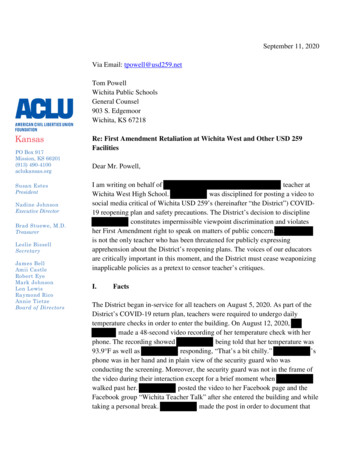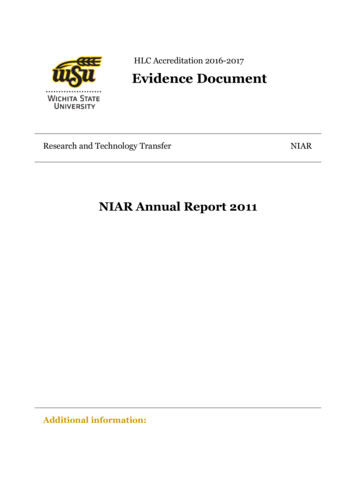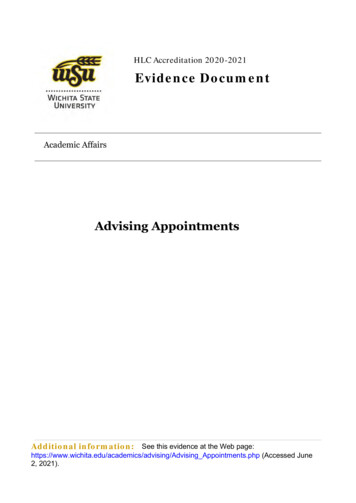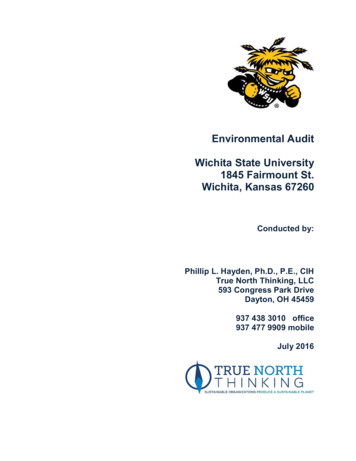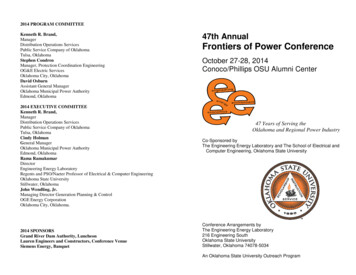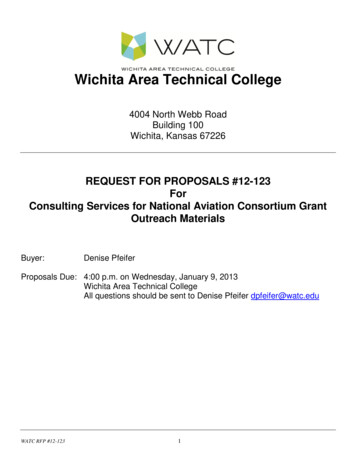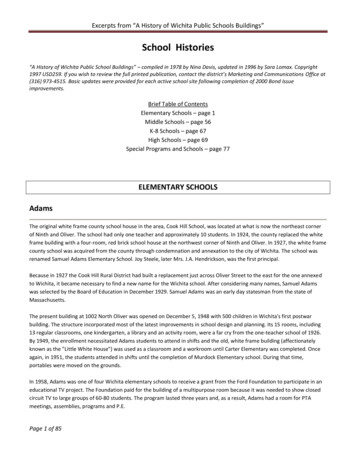
Transcription
Excerpts from “! History of Wichita Public Schools uildings”School Histories“! History of Wichita Public School uildings” – compiled in 1978 by Nina Davis, updated in 1996 by Sara Lomax. Copyright1997 USD259. If you wish to review the full printed publication, contact the district’s Marketing and ommunications Office at(316) 973-4515. Basic updates were provided for each active school site following completion of 2000 Bond Issueimprovements.Brief Table of ContentsElementary Schools – page 1Middle Schools – page 56K-8 Schools – page 67High Schools – page 69Special Programs and Schools – page 77ELEMENTARY SCHOOLSAdamsThe original white frame county school house in the area, Cook Hill School, was located at what is now the northeast cornerof Ninth and Oliver. The school had only one teacher and approximately 10 students. In 1924, the county replaced the whiteframe building with a four-room, red brick school house at the northwest corner of Ninth and Oliver. In 1927, the white framecounty school was acquired from the county through condemnation and annexation to the city of Wichita. The school wasrenamed Samuel Adams Elementary School. Joy Steele, later Mrs. J.A. Hendrickson, was the first principal.Because in 1927 the Cook Hill Rural District had built a replacement just across Oliver Street to the east for the one annexedto Wichita, it became necessary to find a new name for the Wichita school. After considering many names, Samuel Adamswas selected by the Board of Education in December 1929. Samuel Adams was an early day statesman from the state ofMassachusetts.The present building at 1002 North Oliver was opened on December 5, 1948 with 500 children in Wichita's first postwarbuilding. The structure incorporated most of the latest improvements in school design and planning. Its 15 rooms, including13 regular classrooms, one kindergarten, a library and an activity room, were a far cry from the one-teacher school of 1926.By 1949, the enrollment necessitated Adams students to attend in shifts and the old, white frame building (affectionatelyknown as the "Little White House") was used as a classroom and a workroom until Carter Elementary was completed. Onceagain, in 1951, the students attended in shifts until the completion of Murdock Elementary school. During that time,portables were moved on the grounds.In 1958, Adams was one of four Wichita elementary schools to receive a grant from the Ford Foundation to participate in aneducational TV project. The Foundation paid for the building of a multipurpose room because it was needed to show closedcircuit TV to large groups of 60-80 students. The program lasted three years and, as a result, Adams had a room for PTAmeetings, assemblies, programs and P.E.Page 1 of 85
Excerpts from “! History of Wichita Public Schools uildings”The pupil population in the district dropped steadily over the years; however, with the implementation of the integrationplan the enrollment was stabilized at approximately 300 pupils, with about 33 percent of these being minority.In 1981, all windows were replaced with thermal pane steel windows. In 1984, the office was remodeled.At the beginning of the 1988-89 year, sixth grade students were incorporated into the middle school program and boundarylines adjusted, leaving a K-5 enrollment of approximately 225 students, with about 20 percent of those being minority.In April 2000, the voters of the Wichita School District approved a 284.5 million bond issue. The projects began in the fall of2000 and were completed over the next five years. The plan built 19 multipurpose rooms, upgraded science labs, replacedportable classrooms with permanent construction, improved handicap accessibility to all buildings, rebuilt five existingelementary schools, added a new elementary and middle school, expanded seven other elementary schools and providednine new libraries as well as the expansion of nine others. Building infrastructure in 82 buildings was also upgraded, includingthe replacement of antiquated plumbing, updates and expansion of electrical systems, replacement of inefficient or brokenwindows and doors, upgrades of heating and cooling systems, and asbestos abatement when required.Adams received upgraded infrastructure, a new addition which included eight classrooms, renovations including studentsupport classrooms, a library and restrooms on the 2nd floor. The total estimated cost was 2,064,000. On November 27,2000, the Board authorized the district to enter into an agreement with the architectural firm of Jeff Krehbiel & Associates for 177,400 for phase 1B of the bond issue project.On September 10, 2001, the Board of Education authorized the district to enter into a contract for the amount of 2,749,500with E.W. Johnson, Inc. to complete the construction project. The Adams' bond project was completed and the dedicationceremony was held May 20, 2003.AllenAllen Elementary School was built during the school year of 1951-52. The school opened in September 1952 with anenrollment of 579. By the close of school in May there were 664 students, and nine classrooms were on double shifts.Allen was named after Henry J. Allen, a former governor and United States Senator. He served during his outstanding careeras a newspaper editor, member of state and federal boards, in international relief work, and the affairs of the RepublicanParty. He was always a stalwart fighter for good government in the nation, state and city.During the spring of 1953, ten portable units were constructed to provide needed classrooms; however, in September 1953,the enrollment increased to 952. The ten-unit classrooms were inadequate, and seven classes were placed on double shifts.Before Christmas the entire school, except the kindergarten, was on double shift. School closed that year with an enrollmentof 1,038. Allen at that time was the largest school in the city.Booth School, 5920 East Mt. Vernon, was completed, and 177 children were transferred to the new location in January of1954. In the meantime, four more portable units were constructed. This made sufficient classroom space for the secondsemester. Two more portable classrooms were moved in during the years 1956, 1957 and 1958. Griffith School, 1802 SouthBluff, was completed, and 197 children were transferred to the new school on October 15, 1958.As the enrollment decreased, portables were moved from the area until seven remained in 1960. Three more portables weresubsequently added to take care of the increased classrooms for the hearing impaired. As of 1995, there were 14 portableson the Allen campus.Page 2 of 85
Excerpts from “! History of Wichita Public Schools uildings”Hearing impaired special education students were housed at Allen from 1959 through 1990. In 1990, the hearing impairedprogram was moved to Caldwell Elementary School.At the beginning of the 1988-89 year, sixth grade students were incorporated into the middle school program, leaving a K-5enrollment of around 300.On April 12, 1999, the Board of Education approved a construction contract with American Mechanical, Inc. in the amount of 77,861 to complete the boiler replacement including replacing water pipes in the boiler room.In April 2000, the voters of the Wichita School District approved a 284.5 million bond issue. The projects began in the fall of2000 and were completed over the next five years. The plan built 19 multipurpose rooms, upgraded science labs, replacedportable classrooms with permanent construction, improved handicap accessibility to all buildings, rebuilt five existingelementary schools, added a new elementary and middle school, expanded seven other elementary schools and providednine new libraries as well as the expansion of nine others. Building infrastructure in 82 buildings was also upgraded, includingthe replacement of antiquated plumbing, updates and expansion of electrical systems, replacement of inefficient or brokenwindows and doors, upgrades of heating and cooling systems, and asbestos abatement when required.The Architectural firm of PBA Architects, P.A. developed a three-section elementary prototype to be used for Linwood,Enterprise and Allen Elementaries. Eby Construction Co. was awarded the contract to build the new Allen and EnterpriseElementary Schools. The old Allen building was replaced with a new school on the same site for an estimated amount of 4,700,000.The new building was completed in the Fall of 2003. Family and friends of Allen Elementary were invited to a bondcelebration and dedication of the new building held on August 28, 2003.AndersonDue to declining population of school age children in the neighborhoods of Greiffenstein, Wilson and Wells elementaryschools in southeast Wichita - an area known as South City - the Board of Education decided to construct a new building thatwould include the old Wilson structure, and move the three school populations together to create a new neighborhoodschool for the South City area.Grace Wilson Elementary School was completed in August, 1954, and was ready for use at the opening of school onSeptember 1 of that year. The architects were Ramey and Himes, and the general contractor was C.A. Doolittle, Jr.The school was named for Grace V. Wilson, who served the Wichita Schools as supervisor of music from 1928 until her deathin 1952. She was nationally recognized as an educator and she co-authored a series of music books for public schools calledThe American Singer, published by the American Book Company.Construction was begun in 1984 on a large, modern looking building on the site of Wilson School, incorporating the oldbuilding into the new structure. During the construction, students from all three schools were housed at Greiffenstein. Thenew building was named after James E. Anderson, a prominent Wichita black educator who had served several years as anadministrator for the district. Shortly after his retirement, he was killed in an automobile accident in 1978.Carolyn Bridges was given the administrative responsibilities for the three schools and being the district contact forsupervising the progress of the new building construction. The new modern building, designed by Gossen LivingstonAssociates, was completed in 1985.In 1989, the building underwent some radical changes, both in remodeling activities and changes in paradigms that affectedPage 3 of 85
Excerpts from “! History of Wichita Public Schools uildings”the restructuring of the educational programs. The building was rewired with state-of-the-art wiring to accommodate a newpilot program supported by Jostens Learning Corporation. That implemented advanced technology in the form of 250computers - one for every two students - to allow changes in the delivery of services to children which included using thecomputers as tools for learning and writing.At the beginning of the 1988-89 year, sixth grade students were incorporated into the middle school program, leaving a K-5enrollment of approximately 450 students.In April 2000, the voters of the Wichita School District approved a 284.5 million bond issue. The projects began in the fall of2000 and were completed over the next five years. The plan built 19 multipurpose rooms, upgraded science labs, replacedportable classrooms with permanent construction, improved handicap accessibility to all buildings, rebuilt five existingelementary schools, added a new elementary and middle school, expanded seven other elementary schools and providednine new libraries as well as the expansion of nine others. Building infrastructure in 82 buildings was also upgraded, includingthe replacement of antiquated plumbing, updates and expansion of electrical systems, replacement of inefficient or brokenwindows and doors, upgrades of heating and cooling systems, and asbestos abatement when required.Anderson received a new addition including four classrooms, upgrades to the infrastructure and renovation to the studentsupport area for an estimated total cost of 732,000. The plans were prepared by the firm of Gossen Livingston Associates.On March 14, 2005, Caro Construction Co. was contracted to complete Anderson's remodels, as well as those of ColvinElementary. The total cost for this contract was 3,165,050.The Bond project was completed and the dedication ceremony was held May 21, 2006 in conjunction with the retirementparty of Penny Longhofer, who had been principal at Anderson since 2000.BeechIt was with an eye to the future that the Board of Education, on September 15, 1975, purchased land in southeast Wichita fora new elementary school. Three years later, another site was purchased in northeast Wichita for the same purpose. OnAugust 4, 1980, the architectural firm of Griffith and Bonham was appointed to design two elementary school buildings,identical in plan but not in finish, to be located on these two sites.E.W. Johnson, Inc. was awarded the building contract for both locations in the amount of approximately 3,250,000 perbuilding. Construction began on September 7, 1982 at the southeast site. After considering all recommendations, the Boardof Education decided the newest elementary school should bear the name of the local pioneer in the field of aviation, WalterH. Beech.Mr. Beech stands in the front ranks of air pioneers. He not only foresaw the role of the airplane far into the future, buttranslated that foresight into reality, producing a line of outstanding aircraft and establishing the aircraft company whichlater became Raytheon, and then Hawker Beechcraft, and continues to be one of Wichita's major industries. At the age of 23,Mr. Beech made his first recorded solo flight - just 11 years after Orville Wright flew for the first time at Kitty Hawk. Afterserving in the Aviation Section of the U.S. Army Signal Corps as a pilot, engine expert and flight instructor, he came to Wichitaas a test pilot and demonstrator for the Laird Swallow Aircraft Company. He later became vice president and generalmanager of the firm. Following a dispute over whether Swallow frames should be made of metal or wood, Mr. Beech left thecompany in 1924 and organized the Travel Air Company of Wichita, which later merged with Curtiss-Wright AirplaneCompany of New York.In 1932, in the darkest year of the depression, Walter Beech and his wife of two years, Olive Ann, returned to Wichita toestablish the Beech Aircraft Company. The company's products were successful and the firm established itself as a worldleader in civilian and military aircraft. Active to his last day, Mr. Beech was stricken with a heart attack and died suddenlyNovember 29, 1950.Page 4 of 85
Excerpts from “! History of Wichita Public Schools uildings”Walter H. Beech Elementary School opened its doors on August 27, 1984 to 437 anxious students. They were enthusiasticallygreeted by Principal Gloria McAfee and her staff of 36. The building is equipped with a gym, multipurpose room, librarymedia center, facilities for music and art, 23 classrooms, a computer lab, a learning kitchen and much more.At the beginning of the 1988-89 year, sixth grade students were incorporated into the middle school program, leaving a K-5enrollment of approximately 450 students.In April 2000, the voters of the Wichita School District approved a 284.5 million bond issue. The projects began in the fall of2000 and were completed over the next five years. The plan built 19 multipurpose rooms, upgraded science labs, replacedportable classrooms with permanent construction, improved handicap accessibility to all buildings, rebuilt five existingelementary schools, added a new elementary and middle school, expanded seven other elementary schools and providednine new libraries as well as the expansion of nine others. Building infrastructure in 82 buildings was also upgraded, includingthe replacement of antiquated plumbing, updates and expansion of electrical systems, replacement of inefficient or brokenwindows and doors, upgrades of heating and cooling systems, and asbestos abatement when required.Beech received a new addition, which included four classrooms, for an estimated cost of 450,000. On January 24, 2005, theBoard contracted National Contractors, Inc. to complete the Beech, Gammon and Isely Bond projects for 1,633,750.The Bond project was completed and the dedication ceremony was held November 15, 2005.BentonIn the fall of 1957, Mary Benton Elementary School was opened with a staff of nine teachers for grades kindergarten througheight. Mobley and Safely were architects for the building. Mrs. Norma Thomason, first grade teacher, was acting principal.Benton was an outgrowth of Peterson School, District 69, Sedgwick County. The name was selected in honor of Miss MaryBenton who was the first teacher at Peterson in 1875. She began teaching December 13, 1875 and taught for three months ata salary of 75.In the fall of 1959, three classrooms, a storage room and a special services room were added.In the spring of 1960, the patrons of District 69 requested annexation by the Wichita Public School System, and in the fallBenton opened as a Wichita public school with grades kindergarten through six.In 1976, bond funds provided for an addition of six rooms, a library and restrooms. Air conditioning was provided in theoriginal building, as well as the addition. Safely Associates were the architects for the addition.The rapid expansion of special education programs throughout the school system during the 1970s necessitated additionalclassroom space on the west side. In November of 1976, the Board of Education employed Thomas, Harris, Ash and Mason toprovide architectural planning for a three-room addition at Benton to house educable mentally handicapped students.Scheduled to open in 1978, this project was included in planning for capital outlay expenditures.At the beginning of the 1988-89 year, sixth grade students were incorporated into the middle school program, leaving a K-5enrollment of approximately 450 students.In April 2000, the voters of the Wichita School District approved a 284.5 million bond issue. The projects began in the fall of2000 and were completed over the next five years. The plan built 19 multipurpose rooms, upgraded science labs, replacedportable classrooms with permanent construction, improved handicap accessibility to all buildings, rebuilt five existingelementary schools, added a new elementary and middle school, expanded seven other elementary schools and providedPage 5 of 85
Excerpts from “! History of Wichita Public Schools uildings”nine new libraries as well as the expansion of nine others. Building infrastructure in 82 buildings was also upgraded, includedthe replacement of antiquated plumbing, updates and expansion of electrical systems, replacement of inefficient or brokenwindows and doors, upgrades of heating and cooling systems, and asbestos abatement when required.Benton's infrastructure was upgraded, a new addition including 5 classrooms and a kitchen was added, and renovations weremade to the student support area. The school was also made more handicap-accessible.On December 10, 2001, the Board authorized an agreement with the architectural firm of Howard & Helmer Architects, P.A.for phase 2C of the Bond Issue project.On January 12, 2004, the district contracted with Commerce Construction for an amount of 1,943,200 to complete theremodel and addition project. The Bond project was completed and the dedication ceremony was held November 16, 2004.Black Traditional MagnetJessie Hunter Black Elementary School was built in 1954 to meet the needs of the rapidly expanding West Side and to servean area that had formerly been a part of the OK district but had been annexed by the city. The school was completed inOctober of 1954 and was occupied immediately by the pupils and staff who had been holding classes on an afternoon shift atField Elementary School. Leaper and Gilbert were architects for the building.Dedication services were held on the afternoon of Sunday, November 14, 1954, and were attended by members of the Boardof Education, school administrators, staff and other important citizens of the community. At this time, a portrait of Mrs.Jessie Hunter Black, after whom the school was named, was presented to the school by a niece, Mrs. Knorr. Mrs. Black wascredited with being the first public school teacher in Wichita, having taught several years as Miss Jessie Hunter.The initial enrollment was 300. This rapidly increased, and a peak enrollment of 580 was reached in 1965. Through the years,12 portable classroom units were placed on the school site to provide for expanded enrollment and special services. In 1968,two classrooms were combined to develop an adequate library facility.The 1974 bond election included improvements for Black Elementary. After a year of planning, renovation and constructionwere begun. The kindergarten area was enlarged, and the office area was extended. The old library, teacher lounge andmusic room were converted into four classrooms. The new addition included five classrooms, a library media resource centerwith conference and instructional areas, instrumental music room, multipurpose room, restroom and inner courtyard.Renovation and construction were completed in November 1976 at a cost of 642,718. The building was occupied inDecember and the need for portables on the school site eliminated.At the beginning of the 1988-89 year, sixth grade students were incorporated into the middle school program, leaving a K-5enrollment of approximately 300 students.In 1989, 16 ceiling fans were placed in eight classrooms and the remaining four classrooms without air conditioning receivedfans by December 1990. The project was financed by the Black Elementary PTA.In 1993, the school board responded to community interest in a traditional magnet school and Black Traditional ElementaryMagnet School was created.In April 2000, the voters of the Wichita School District approved a 284.5 million bond issue. The projects began in the fall of2000 and were completed over the next five years. The plan built 19 multipurpose rooms, upgraded science labs, replacedportable classrooms with permanent construction, improved handicap accessibility to all buildings, rebuilt five existingelementary schools, added a new elementary and middle school, expanded seven other elementary schools and providedPage 6 of 85
Excerpts from “! History of Wichita Public Schools uildings”nine new libraries as well as the expansion of nine others. Building infrastructure in 82 buildings was also upgraded, includedthe replacement of antiquated plumbing, updates and expansion of electrical systems, replacement of inefficient or brokenwindows and doors, upgrades of heating and cooling systems, and asbestos abatement when required.The district entered contracts with architects Hanney & Associates and with Bauer and Son Construction to complete theBlack and McLean remodel and addition projects.The Black bond project was completed for the Fall of 2003, and the school held their bond celebration and dedication onSeptember 2, 2003.Bostic Traditional MagnetThe Leicle Bostic Traditional Elementary Magnet School is housed in the former Kistler Elementary School which wasoriginally a part of Common School District No. 184, Kechi. The district came into the Wichita Public School System byattachment in July of 1963.The site is located on a farm which was formerly owned by Mr. and Mrs. Foster. This farm was a part of the original OsageTrust Lands (1873).The original school, containing three classrooms and a gymnasium, was completed in 1953, and classes actually started inJanuary of 1954. An addition of two permanent classrooms was completed in 1955. Three portable classrooms were built onthe site in 1958, and three permanent classrooms were added to the main building in 1962. Two additional portableclassrooms were added in 1963, two in 1966, and a portable restroom in 1969.Kistler was closed as an attendance center in May of 1984. The building was used for storage until 1988. From 1988 to 1994the building was used as a Gammon Elementary School annex.In 1994-95, the building was renamed Leicle Bostic Traditional Magnet Elementary School after a former USD 259 principal,and Gammon students returned to the base school. At present it houses one classroom each (K-5) and has an enrollment of155 students. The two other classrooms are utilized as a library and computer lab.At the April 8, 1996 meeting, the Board of Education approved the closing of the Bostic School building at the end of the1995-96 school year and the entire program moved to the Stearman site at 8103 East Gilbert, keeping the Bostic name.In April 2000, the voters of the Wichita School District approved a 284.5 million bond issue. The projects began in the fall of2000 and were completed over the next five years. The plan built 19 multipurpose rooms, upgraded science labs, replacedportable classrooms with permanent construction, improved handicap accessibility to all buildings, rebuilt five existingelementary schools, added a new elementary and middle school, expanded seven other elementary schools and providednine new libraries as well as the expansion of nine others. Building infrastructure in 82 buildings was also upgraded, includedthe replacement of antiquated plumbing, updates and expansion of electrical systems, replacement of inefficient or brokenwindows and doors, upgrades of heating and cooling systems, and asbestos abatement when required.The school district hired the firm of Winter Architects, and Caro Construction Co. was utilized to complete the Bond project.The infrastructure at Bostic was upgraded, and the bus load/unloading areas revamped.Bostic's Bond project was completed for the amount of 865,945 and the school's dedication ceremony was held September4, 2003.Page 7 of 85
Excerpts from “! History of Wichita Public Schools uildings”Bryant Core Knowledge MagnetJohn B. Bryant Elementary School was built to alleviate overcrowded conditions at three other elementary schools: Black,Dodge and OK. Ash and Harrison were the architects for the structure.The school opened its doors in January 1957, at the start of the second semester, to students who lived between NewellthStreet on the south to 13 Street on the north, and from West Street on the east to the "Big Ditch" on the west. The numberof students entering was 430, and they were taught by 14 teachers. All were housed in the one building.In the years Bryant has been in operation, its enrollment has climbed as high as 732. The addition of portables to the schoolsite began in the 1958-59 school year and continued until, in addition to the 14 classrooms of the original building, in 1970there were 11 portable classrooms.In 1976, an addition consisting of eight classrooms, three classrooms for educable mentally handicapped, a multipurposeroom, and a new mechanical room for the entire building was constructed. The old multipurpose room was remodeled into amedia center, and the office areas were renovated. Architects for the addition were Carmichael/Associates.In 1981, all windows were replaced with thermal pane steel windows. In 1985, a stone room was added, and in 1987, acomputer lab added.Enrollment has been declining since the late 1980s. At the beginning of the 1988-89 year, sixth-grade students wereincorporated into the middle school program, leaving a K-5 enrollment of approximately 400 students.Bryant School was named for John B. Bryant, a well-known Wichita lawyer who served many years as a member of theWichita Board of Education. On July 13, 1998, the Board of Education approved a name change effective with the 1998-99school year. Bryant Elementary was changed to Bryant Core Knowledge Magnet.In April 2000, the voters of the Wichita School District approved a 284.5 million bond issue. The projects began in the fall of2000 and were completed over the next five years. The plan built 19 multipurpose rooms, upgraded science labs, replacedportable classrooms with permanent construction, improved handicap accessibility to all buildings, rebuilt five existingelementary schools, added a new elementary and middle school, expanded seven other elementary schools and providednine new libraries as well as the expansion of nine others. Building infrastructure in 82 buildings was also upgraded, includingthe replacement of antiquated plumbing, updates and expansion of electrical systems, replacement of inefficient or brokenwindows and doors, upgrades of heating and cooling systems, and asbestos abatement when required.As a result of Bond project construction, Bryant received a new addition that includes five classrooms. Renovations were alsomade to student support and other classrooms, and a covered loading/unloading area for special education was provided aswell.Working on this project were Spangenberg Phillips Architecture and construction company Hahner, Foremen and Harness,Inc. The addition and renovation project was 1,596,363. The Bond project dedication ceremony was held January 27, 2005.Page 8 of 85
Excerpts from “! History of Wichita Public Schools uildings”Buckner Performing Arts MagnetBuckner Elementary School was opened in the fall of 1956 with seven regular teachers and the principal. Special personnel, inaddition to the secretary and custodian, included a nurse, counselor, a lip-reading teacher, vocal music and instrumentalmusic teacher. The new building was designed to house 225 pupils, and 208 were enrolled in kindergarten through grade sixthat first year. There were seven classrooms in the original building.Seven additional classrooms, a multipurpose room and library were added to the structure in 1958. Increased enrollmentsand remodeling to provide space for the Buckner Demonstration Library required the addition of two portable classrooms in1961, one in 1962 and one in 1969. The architects for the original structure and the 1958 addition were Hibbs, Robinson
In April 2000, the voters of the Wichita School District approved a 284.5 million bond issue. The projects began in the fall of 2000 and were completed over the next five years. The plan built 19 multipurpose rooms, upgraded science labs, replaced
